A Massive MIMO Channel Estimation Method Based on Hybrid Deep Learning Model With Regularization Techniques
Abstract
The channel estimation technique is crucial for the development of wireless communication systems. By accurately estimating the channel state, transmission parameters such as power allocation, modulation schemes, and encoding strategies can be optimized to maximize system capacity and transmission rate. In this paper, we propose a hybrid deep learning model for channel estimation in multiple-input multiple-output (MIMO) wireless communication system. By combining the advantages of convolutions and gated recurrent units (GRUs), the generalization capability of deep learning models across various wireless communication scenarios can be fully utilized. Furthermore, a series of regularization techniques such as data augmentation and structural complexity constraints have been introduced to avoid overfitting problems. The stochastic gradient descent (SGD) based on error backpropagation is used to iteratively train the model to convergence. During the simulation process, we have validated the effectiveness of the hybrid deep learning model on two wireless channel conditions, including quasi-static block fading and time-varying fading condition. All the samples are generated offline with SNRs from 10 to 40 dB with a step size of 5 dB. The comparison results with a series of conventional methods and deep learning models have proven the effectiveness of the proposed method.
1. Introduction
Compared to traditional wireless communication where only one antenna exists for signal transmission and reception, the multiple-input multiple-output (MIMO) communication [1] is a technology that utilizes multiple antennas for signal transmission and reception. MIMO technology is able to effectively increase the capacity, throughput, and reliability of wireless communication systems by using multiple antennas at the transmitter and receiver ends to send multiple independent data streams over different transmission paths at the same moment. With MIMO technology, multiple transmission paths in a multipath channel environment can be utilized to increase channel capacity and improve the spectral efficiency of the system [2]. Together with spatial diversity and spatial multiplexing, MIMO technology can further improve the whole system’s interference immunity and transmission quality. At present, MIMO technology has been widely used in wireless communications to improve data transmission performance and network capacity, such as wireless fidelity (Wi-Fi), long-term evolution (LTE), and fifth-generation (5G) communication systems [3].
Channel estimation [4, 5] in MIMO communication systems refers to the estimation of channel state information (CSI) between multiple antennas, that is, the estimation of channel gain and phase information between each antenna, which plays an important role in MIMO systems. Accurate channel estimation helps to reduce distortion and interference in signal transmission, thereby improving system’s transmission performance and reliability [6]. Specifically, MIMO systems with the estimated CSI can dynamically adjust transmission parameters and modulation schemes to improve communication performance and capacity. By utilizing CSI, the MIMO communication systems are also able to perform precoding and postprocessing operations to maximize transmission efficiency, reduce multipath signal interference, and improve anti-interference capabilities [7]. In addition, accurate channel estimation can be used to optimize the power allocation strategy, helping the wireless communication system allocate power reasonably to maximize energy efficiency [8].
In MIMO systems, signal estimation still faces a series of factors, such as multipath channels [9], spatiotemporal correlation [10], channel fading [11], pilot design [12], antenna selection and configuration [13], and hardware conditions [14]. There are multiple transmission paths in MIMO systems, where the signal arrival time and amplitude on each path may be different. This leads to signals being mixed together at the receiving end, making it difficult to accurately estimate the independent CSI between each antenna [15]. The channels between antennas are often spatiotemporal correlated, meaning that the channel states between adjacent antennas are relatively similar. Therefore, it is necessary to consider the impact of spatial correlation on estimation accuracy. In practical communication scenarios, the time-varying nature of wireless channels results in their states changing over time, which requires channel estimators to track changes such as channel fading in a timely manner. Moreover, channel estimation typically requires sending some known pilot symbols for the receiver to estimate, but pilot design needs to consider issues such as the selection, positioning, and insertion of pilot sequences to ensure the effectiveness and accuracy of pilots. In addition, channel estimation usually requires high-speed sampling and processing, which has certain hardware performance requirements [16]. In real communication systems, achieving efficient channel estimation under limited hardware resources is also a challenge. The reasonable setting of antenna quantity, position, and directionality is also a key factor in achieving well channel estimation performance [17].
At present, channel estimation methods in MIMO systems can be divided into four categories: pilot-based methods, frequency-domain analysis–based methods, compressive sensing–based methods, and deep learning (DL)–based methods. The relevant research directions are summarized in Figure 1. The pilot-based method estimates the channel response matrix by sending a known pilot sequence and then receiving the transmitted signal. By comparing the difference between the received signal and the known pilot sequence, the channel characteristics can be inferred. The evaluation method using the least square (LS) [18] is applicable to single-input single-output (SISO) systems. The minimum mean square error (MMSE) method [19] incorporates noise and signal correlation on the basis of LS, making it more suitable for MIMO systems. The time-domain pilot interpolation method [20] interpolates the pilot signal in the time domain, reducing the impact of interpolation errors on channel estimation. The method based on frequency domain analysis first converts the received signal to the frequency domain and then compares the frequency-domain similarity between the received signal and the pilot sequence to obtain an accurate estimation of the channel response matrix. The commonly used similarity measurement methods include maximum likelihood estimation (MLE) [21], channel state information feedback (CSIF) [22], and orthogonal matching pursuit (OMP) [23]. Compressive sensing utilizes the sparsity of the channel response matrix for channel estimation. Based on the sparse representation of the received signal, the sparse signal recovery algorithm is introduced to reconstruct the channel response matrix. For example, Dantzig selector [24] transforms the channel estimation problem into the sparse optimization problem, using a convex combination of L1-norm and L∞-norm as a penalty function to find the optimal sparse solution. Low rank matrix factorization [25] decomposes the channel matrix into a weighted sum of low rank matrices and then solves an optimization problem to estimate the channel response matrix. DL methods utilize deep neural network models to complete the channel estimation. By conducting end-to-end channel feature learning on a large amount of training data, the deep network models can directly recover CSI from the received signal. Common DL models include convolutional neural networks (CNNs) [26, 27], long short-term memory (LSTM) [28, 29], graph neural networks (GNNs) [30, 31], and Transformers [32, 33].
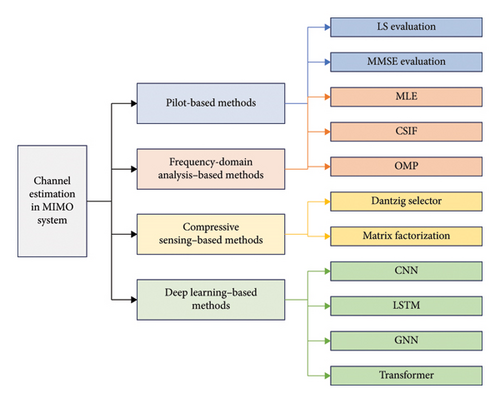
In recent years, the DL method has achieved remarkable achievements in multiple fields and has gradually been developed for wireless communication and signal processing, such as modulation classification [34–36], parameter estimation [37], spectrum sensing [38, 39], the design of intelligent hypersurfaces [40], and long-term prediction [41, 42]. DL models with adaptive learning capabilities can learn complex nonlinear mapping relationships of channels from a large amount of training data, thus adapting to various communication scenarios and channel environments. The end to end DL can automatically extract effective features from original data without the need for manually designed features or preprocessing, simplifying the system designing process. A large number of studies have been developed for DL enabled channel estimation in MIMO systems. For example, Balevi, Doshi, and Andrews [43] proposed a channel estimation method based on DL for large-scale MIMO systems with limited multicell interference. The channel estimator adopts a specially designed deep neural network based on depth image priors, which first denoises the received signal and then performs traditional LS estimation. Kang, Chun, and Kim [44] designed a deep autoencoder via CNN for joint channel estimation and pilot signal design in the quasi-static block fading scenario. In the time-varying fading communication scenario, a new channel estimation method was then developed by connecting recurrent neural network (RNN) to CNN. Gao et al. [45] introduced an attention assisted DL channel estimation framework for traditional large-scale MIMO communication systems and designed an embedding method to effectively integrate attention mechanisms into the fully connected neural network. Zhang et al. [46] constructed a tensor trained deep neural network (TT-DNN) to address the challenge of time-varying channel estimation in MIMO communication systems. Belgiovine et al. [47] suggested building a multilayer perceptron (MLP) structure to enable the channel estimation task on large-scale parallel architectures, such as field-programmable gate array (FPGA). By utilizing the angular domain compressibility of massive MIMO channels, Ma and Gao [48] designed a DL structure consisting of a dimensionality reduction network for simulating pilots and a reconstruction network for estimating channels, to efficiently reconstruct high-dimensional channels from insufficient measurements. Liu and Huang [49] pointed out that networks based on multilayer CNN can extract the inherent sparse features of mmWave massive MIMO channels through training and learn sparse channel support. However, DL often requires a large amount of data to train the model and condense expert knowledge, which is difficult and expensive in practical communication systems. Due to the involvement of large-scale parameter deployment and complex computing processes, DL models require high-performance hardware devices and a large amount of computing resources to support model training and inference. It is challenging to deploy channel estimators on resource-limited devices and systems [50]. In addition, the structural complexity of deep neural network and the opacity of high-dimensional optimization process lack interpretability, making it difficult to understand the internal operating mechanism of the model and make targeted improvements [51].
In fact, the use of DL for channel estimation still faces a series of problems, among which the most crucial is to choose an appropriate model structure to handle wireless signals. Wireless signals with temporal representation are subject to interference from various factors, which poses a challenging requirement for the model’s feature extraction capability. In this paper, we propose a hybrid DL model for channel estimation in MIMO wireless communication system. By combining the advantages of conventional convolution and gated recurrent unit (GRU), the generalization capability of DL models across various wireless communication scenarios can be fully utilized. Furthermore, a series of regularization techniques such as data augmentation and structural complexity constraints have been introduced to avoid overfitting problems. The stochastic gradient descent (SGD) based on error backpropagation is used to iteratively train the model to convergence. During the simulation process, we have validated the effectiveness of the hybrid DL model on two wireless channel conditions, including quasi-static block fading and time-varying fading condition. The comparison results with a series of conventional methods and DL models have proven the effectiveness of the proposed method.
The remainder of this paper is organized as follows. Section 2 first introduces the MIMO communication system model. Section 3 presents the hybrid DL model for channel estimation. In Section 4, we introduce the adopted regularization technique for improving the generalization capability of the DL model. Simulation results and analysis are shown in Section 5. Finally, we conclude our work in Section 6.
2. MIMO System Model
The MIMO communication system utilizes multiple antennas for wireless communication, typically configured with multiple antennas at both the transmitting and receiving ends. By utilizing spatial multiplexing and diversity techniques, the MIMO communication system is able to significantly improve channel capacity, transmission rate, and spectrum utilization. In addition, the MIMO system utilizes the multipath propagation effect in wireless channels to transform the originally harmful multipath reflections into favorable factors for improving system performance. At present, the MIMO communication technique has been widely used in 5G communication systems. If the intelligent reflective surface (IRS) is introduced, the propagation path of wireless channels can be dynamically adjusted to make wireless channel characteristics more controllable. The IRS improves signal coverage and transmission quality, enhancing the accuracy of channel estimation.
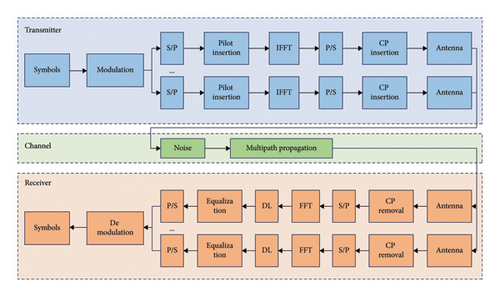
The data of each antenna are converted from serial to parallel (S/P), and then the known pilot signal is inserted into each layer along with the data. Then the inverse fast Fourier transform (IFFT) is applied to x, transforming it back into the time domain. Finally, a cyclic prefix (CP) with a length of NG is inserted as a guard interval to alleviate inter-symbol interference by using CP insertion blocks.
At the receiver side, the received signal is first separated to process the signals received by different antennas separately, such as space-time equalization and space-time demodulation. Then the signals received by multiple antennas that have undergone signal processing are combined into a single overall signal stream, which is converted from parallel to serial (P/S). By utilizing the proposed DL model, the 5G channel can be estimated based on the received signal and known information to obtain the CSI. The merged signal is demodulated to convert it into a baseband signal. Finally, the demodulated signal is decoded and mapped to restore the data information sent by the transmitter.
3. Hybrid DL Model
3.1. Channel Estimation
Therefore, the key to the channel estimation task lies in developing a reliable DL model structure that can accurately capture the channel characteristics under various wireless communication conditions.
3.2. Model Structure
In this section, we introduce the proposed hybrid DL model structure for channel estimation. The specific structure is shown in Figure 3. The hybrid DL model can obtain more comprehensive feature representations by integrating different types of structures. A single CNN performs well in processing context, while the LSTM has an advantage in processing temporal data. By combining convolution and GRU, hybrid DL models can possess better feature extraction and modeling capabilities than single model, thus possessing good generalization ability across various types of communication scenarios. The channel estimation task in MIMO systems involves the spatiotemporal correlation between multiple antennas. The hybrid DL model can fully utilize the modeling ability of each module for spatial and temporal relationships. For example, CNN can capture spatial correlations in antenna arrays, while LSTM can capture long-term dependencies in temporal data. By integrating the feature extraction capabilities of multiple modules, hybrid models can reduce the risk of overfitting and improve performance on unseen data. This is very important for the practical application of MIMO channel estimation tasks, as communication channel conditions will change with time and location.
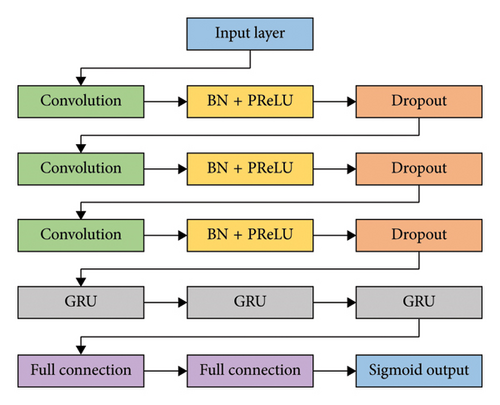
In the equations, the superscript i represents the ith dimension of the variable, indicating that BN operates independently across various dimensions of a mini-batch set. x and y represent input and output, respectively. M denotes the batch size. μ and σ denote mean and standard deviation, respectively. γ and β represent translation and scaling parameters, respectively. ε is a small constant to ensure the numerical stability. To a certain extent, BN has the effect of regularization. By normalizing each mini-batch set of training samples, BN introduces a certain amount of distribution noise, which helps to suppress the overfitting problem faced by DL models.
After each PReLU activation function, dropout [54] is introduced to randomly remove some neurons with a certain probability. Dropout can improve the generalization capability of DL models by sparsifying the output dimensions of each layer to constrain the structural complexity of the model.
GRU controls the flow and forgetting of information by providing mechanisms for update gates and reset gates, thereby better handling the dependency relationships of long sequences and capturing important time-related information.
Finally, the channel estimation results are obtained through two fully connected layers with a sigmoid function.
3.3. Model Training
In the above equations, m and v are biased first and second moment estimates, respectively. and are bias-corrected first and second moment estimates, respectively. ∇t represents gradient at the tth training iteration. The DL model undergoes iterative training until the objective function converges. Then the converged model can be used for channel estimation of new received signals.
4. Regularization of Channel Estimator
DL models often have a large number of parameters, which gives them high fitting ability on training data but also easily leads to overfitting. In other words, the DL model performs well on training data but performs poorly on unseen test data. By introducing regularization technique, the DL model is able to suppress the overfitting problem, improve its generalization capability, and maintain the stable channel estimation performance under different channel conditions.
4.1. Data Augmentation
In practical applications, collecting large-scale real channel data may face difficulties due to high costs. Data augmentation technique effectively expands the dataset by transforming and perturbing existing data to generate more training data. Data augmentation generates more diverse data samples, allowing DL models to be exposed to more wireless channel conditions during training, thereby improving its generalization ability. In this case, the DL model will focus more on the essential characteristics of the wireless channel rather than remembering specific data samples, which helps the model maintain well performance in the face of unseen channel environments.
During the process of applying DL model to channel estimation, we can increase the diversity of training data, thereby reducing the risk of overfitting and improving the generalization ability of DL models on unseen signals. In practical applications, appropriate data augmentation methods can be selected and adjusted according to the specific requirements of MIMO systems and channel estimation tasks. During the simulation process, we first perform the random rotation operation on the antenna vectors of the received signal through randomly selecting the rotation angle and performing corresponding mathematical transformations on the antenna vector. The rotation operation can simulate the position and direction changes between antennas, thereby increasing the model’s adaptability to different channel states. The amplitude of each antenna receiving the signal was also randomly scaled. Scaling operations can simulate different signal propagation distances, enabling DL models to adapt to different channel fading situations. Moreover, the addition of random noises in the received signals can simulate noise interference in real communication environments. We introduce the random noise that follows the specific distribution in the amplitude or phase of each antenna receiving the signals. By increasing the range and amplitude of noise changes, the DL model can better learn its resistance to noises. Furthermore, flipping and translating in the temporal dimension can simulate changes in signal delay, while mirroring in the spatial dimension can simulate changes in antenna position or direction.
4.2. Constraints on Structural Complexity
One critical challenge faced by DL is a well trade-off between optimization and generalization. Fewer parameters make it difficult to extract robust features, while more parameters can easily make the model overfitting. The constraint of the structural complexity in DL models is an important aspect, as overly complex models may lead to overfitting and wastage of computational resources. We empirically set up a hybrid DL model structure. We initially designed a relatively simple model architecture to limit the complexity of the model. Compared to typical deep neural network structures used for processing images or temporal signals, our proposed model structure has fewer convolutional kernels. For example, considering the number and length of signals, fewer layers and fewer neurons were used in the hybrid DL model, with 32/64/64 convolutional kernels in the first three convolutional layers. The L2 regularization term is also introduced into the objective function of the model, which plays a role in constraining the complexity of the model structure by limiting the magnitude of weights during the training process. In addition, L2 regularization shares weights with highly correlated features, thereby alleviating the impact of collinearity. The early stopping technology has also been introduced into the training process of the model. By monitoring the performance changes of the model on the training set, training can be stopped before the model begins overfitting. This can prevent the model from becoming too complex, thereby improving the accuracy of the model.
5. Simulation Results and Analysis
5.1. Simulation Settings
During the simulation process, many settings followed the widely adopted situations in many standards. For example, the number of transmitting and receiving antennas used is {2, 4, 8} in 4G LTE and {16, 32, 64, 128} in 5G and beyond 5G. The layout of transmitting and receiving antennas is determined based on actual communication system requirements and available resources. It is also common to use pilot signals of appropriate length like 8, 16, 32, and 64 in these standards. The length of the signal is set as 1024. The 128-QAM modulation scheme is adopted, and the Rician channel models with quasi-static block fading and time-varying fading are designed. The elements of channel noises are independently drawn from the additive Gaussian distributions. A total of 120,000, 30,000, and 30,000 training, validation, and testing samples are used for training and evaluation of the hybrid DL model.
As for the training process of the proposed hybrid DL model, the samples are generated offline with SNRs from 10 to 40 dB with a step size of 5 dB. During the whole training process, hyperparameters including the learning rate, batch size, training epoch, L2-regularization intensity, and dropout rate are set to 0.01, 64, 30, 0.0005, and 0.4, respectively. The above hyperparameters are empirically set, taking into account the complexity of the channel estimation task and the difficulty of optimization. All the training and testing are conducted with PyTorch using the workstation consisting of Intel i7-13700K, NVIDIA GeForce RTX 4080 GPU, and 32 × 2 GB DDR5 RAM.
5.2. Performance Analysis
In order to observe the effectiveness of the proposed method, a series of experiments have been conducted and analyzed. As shown in Figure 4, we first observe the channel estimation performance of the proposed hybrid DL model under the different number of transmission antennas, including {2, 4, 8, 16, 32, 64, 128}. The wireless channel estimation performance of the hybrid DL model is consistent under two channel conditions. According to the results, it can be seen that as the number of transmitting antennas increases, the error of channel estimation gradually increases. As the number of transmitting antennas increases, the correlation between antennas, that is, the degree of mutual influence between signals from different antennas, will increase. When the correlation increases, the channel estimation algorithm may be affected by interference. As the number of transmitting antennas increases, the system will allocate total power to more antennas, resulting in a corresponding decrease in signal power on each transmitting antenna. Lower signal power may cause the signal to be more affected by noise, leading to an increase in channel estimation error. In addition, multipath interference between multiple transmitting and receiving antennas may lead to increased channel estimation errors. In addition, as the SNR increases, the channel estimation error gradually decreases from 0.001 to 1 × 10−5, which can be negligible in the practical applications.
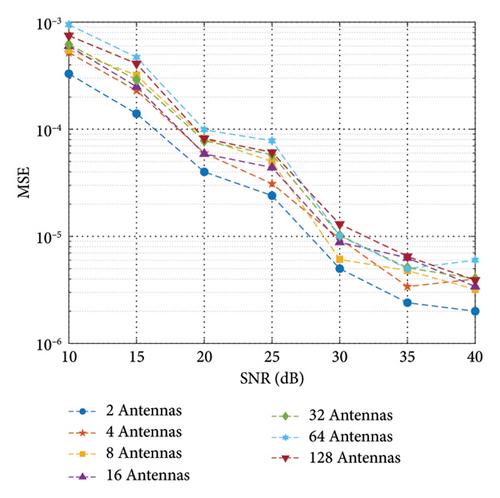
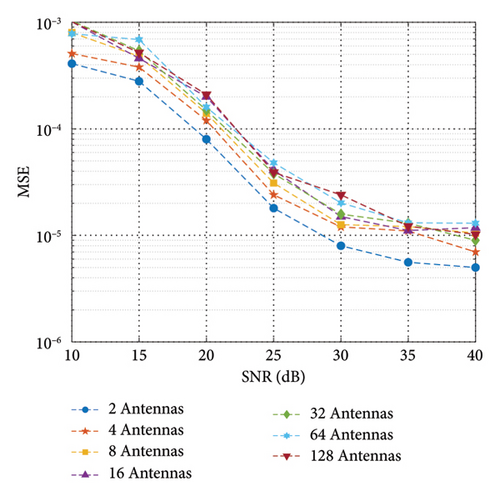
On the other hand, the overall performance of channel estimation gradually improves with the increase of SNR. Under high SNR conditions, the signal power is relatively high, while the noise power is relatively low. Under low SNR conditions, the noise power may approach or even exceed the signal power, which increases the degree of mixing between the signal and noise and reduces the accuracy of channel estimation. A higher SNR can provide a larger dynamic range of signals, i.e., a larger range of differences between the received signal strength and amplitude. The channel estimation method needs to accurately estimate the amplitude and phase of the signal, and a higher SNR makes it easier for channel estimation methods to identify and extract the dynamic range of the received signal, thereby improving the accuracy of channel estimation.
Then we report the channel estimation performance of the proposed hybrid DL model under different number of pilots, such as 8, 16, 32, and 64, as shown in Figure 5. An increase in the number of pilot signals helps improve channel estimation performance. A larger number of pilot signals mean that there are more known channel samples available for utilization, providing more information and enabling channel estimation algorithms to more accurately capture the characteristics of the channel. In MIMO systems, the channel is a complex multidimensional matrix due to the presence of multiple transmitting and receiving antennas. Increasing the number of pilot signals is able to improve the degree of freedom of channel estimation, i.e., increasing the number of observations on each element of channel matrix, which can better constrain the channel estimation problem and make the estimation more accurate. Moreover, more observation data can help DL models better remove noise and interference and improve model stability and robustness.
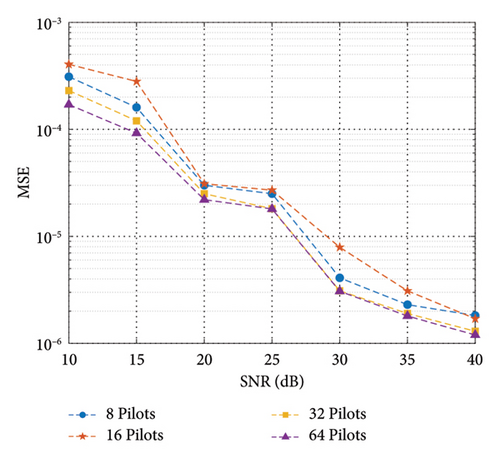
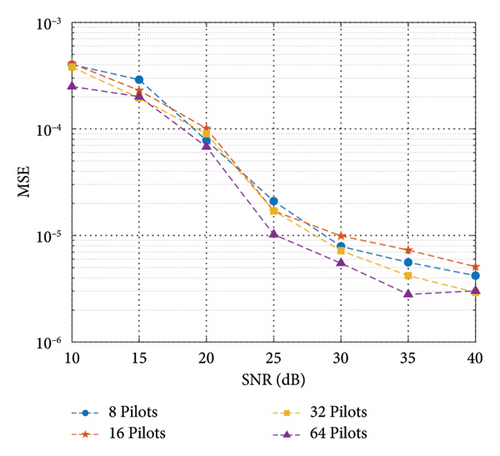
In order to verify the superiority of the proposed method, we compared different channel estimation algorithms and different DL models, including traditional methods (i.e., MMSE and LS) and DL models (i.e., convolutional AE and LSTM). As shown in Figure 6, the proposed hybrid DL method achieves the best channel estimation results on both quasi-static block fading and time-varying fading conditions. It is worth noting that DL models have shown better channel estimation performance than traditional methods. The channel estimation problem of MIMO systems often involves complex nonlinear mapping relationships, and traditional linear and LS estimation methods often cannot fully capture and model this complexity. DL models have stronger model fitting capabilities and can learn more complex channel mapping relationships through multilayer neural networks, thereby improving the accuracy of channel estimation. Compared to multistage processing in traditional methods, end-to-end learning can improve the integrated performance of the entire channel estimation system, reduce the need for signal processing and feature extraction, and reduce system complexity. Compared to single CNN or LSTM models, the hybrid model possesses stronger channel feature learning capability. The hybrid DL model combines the spatial analysis capability of CNN with the temporal processing capability of LSTM, making it better able to handle complex channel conditions.
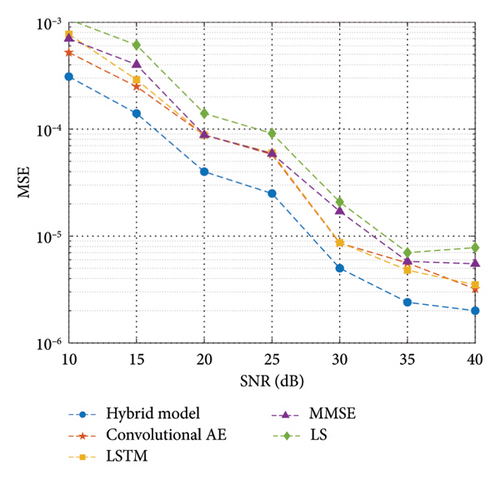
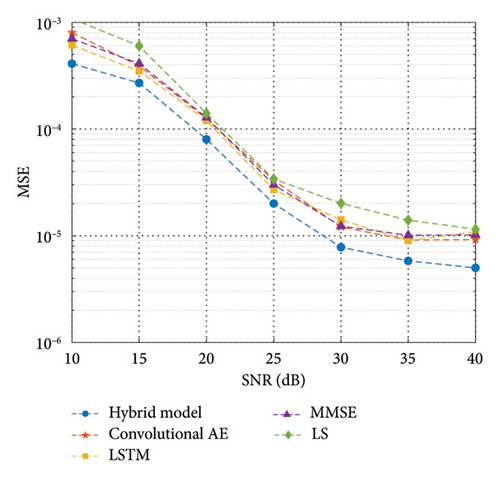
In order to observe the robustness of channel estimation performance to the model structure, we further observe the channel estimation results of DL at different sizes, as shown in Figure 7. The increase in the scale of DL models will increase the number of model parameters, thereby enhancing the fitting ability of the model. When the model size is too large, it is easy for the model to overfit the training data, resulting in overfitting of noisy and variable channel conditions and losing the generalization ability to unknown data. Large-scale DL models typically require more training data for parameter tuning and optimization. If the training data are insufficient, especially in cases where the diversity of channel conditions is not high, large-scale models may overfit the training data and fail to generalize well to unknown channel conditions. Considering the deployment difficulties and limited computing resources encountered in practical wireless communication applications, we further observe the inference speeds and corresponding channel estimation results of hybrid DL models of different sizes. According to the results in Table 1 where 0.6x represent a reduction of 0.6 times in the number of model parameters compared to before, an appropriate model size like 0.8x can achieve a well trade-off between inference speed and channel estimation accuracy.
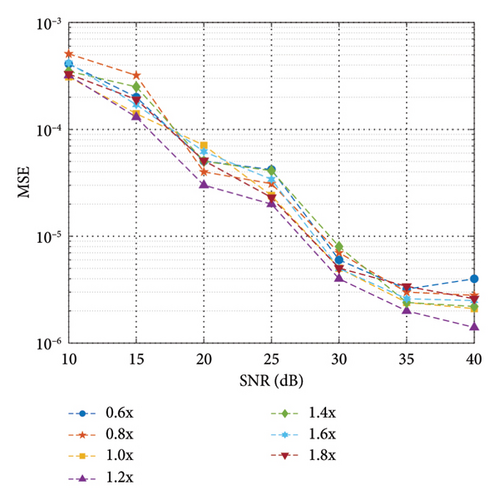
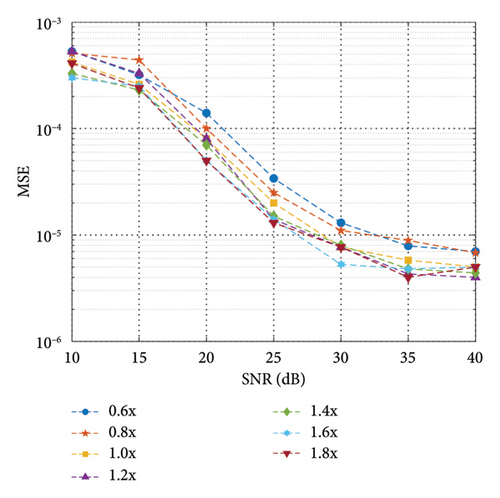
| Model size | 0.6x | 0.8x | 1x | 1.2x | 1.4x | 1.6x | 1.8x |
|---|---|---|---|---|---|---|---|
| Speed (ms) | 6.8 | 9.3 | 11.2 | 13.1 | 15.5 | 17.6 | 18.7 |
| MSE (quasi-static) | 3.06 × 10−3 | 2.44 × 10−3 | 2.21 × 10−3 | 2.17 × 10−3 | 2.14 × 10−3 | 2.12 × 10−3 | 2.15 × 10−3 |
| MSE (time-varying) | 3.22 × 10−3 | 2.78 × 10−3 | 2.46 × 10−3 | 2.40 × 10−3 | 2.39 × 10−3 | 2.37 × 10−3 | 2.39 × 10−3 |
6. Conclusions
In this paper, we propose a hybrid DL model for channel estimation in MIMO wireless communication system. By combining the advantages of convolution and GRU, the generalization ability of DL models across various communication scenarios can be fully utilized. Furthermore, a series of regularization techniques such as data augmentation and structural complexity constraints have been introduced to avoid overfitting problems. The SGD based on error backpropagation is used to iteratively train the model to convergence. During the simulation process, the comparison results with a series of methods (e.g., conventional CNN, LSTM, MMSE, and LS) have proven the effectiveness of the proposed method on both quasi-static block fading and time-varying fading conditions. Moreover, the performance of the proposed hybrid DL model at different scales in dealing with wireless channel estimation has also been observed. Experimental results demonstrate that the hybrid DL model is able to achieve a well trade-off between the channel estimation accuracy and the structural complexity.
Although DL has shown potential in addressing channel estimation task, they still face a series of challenges. The wireless communication environment is usually dynamically changing, and channel characteristics change rapidly. DL models may struggle to quickly adapt to these changes without retraining. Although online learning and incremental learning methods can partially alleviate this problem, they also bring additional complexity and computational overhead. DL models are considered as “black boxes,” since it is difficult to explain their internal workings and decision-making processes. In the field of wireless communications, understanding the decision-making process of models is critical, especially when key decisions and subsequent optimizations need to be made. Besides, DL models are sensitive to noise and attacks on input data, while channel data may be subject to various interferences and malicious attacks. Therefore, improving the security and robustness of the model is also an important research direction.
Conflicts of Interest
The authors declare no conflicts of interest.
Funding
This research was supported by Shandong Provincial Natural Science Foundation (Grant no. ZR2023QF125) and Programme for Young Innovative Research Team in Higher Education of Shandong Province (Grant no. 2024KJH005).
Acknowledgments
This research was supported by Shandong Provincial Natural Science Foundation (Grant no. ZR2023QF125) and Programme for Young Innovative Research Team in Higher Education of Shandong Province (Grant no. 2024KJH005).
Open Research
Data Availability Statement
The experimental data used to support the findings of this study are included within the article.




